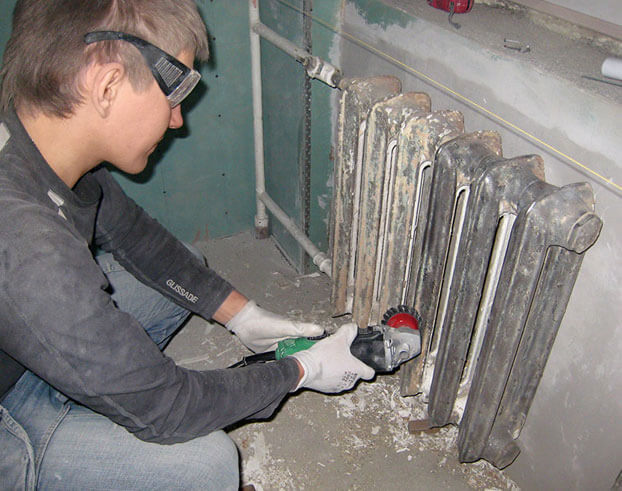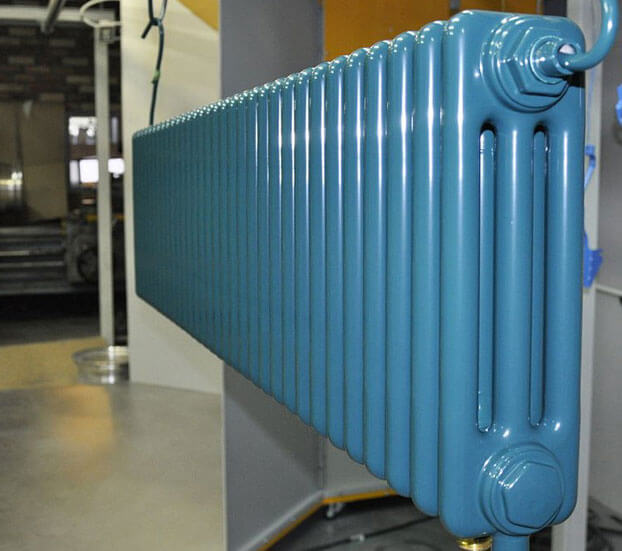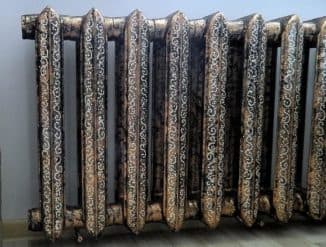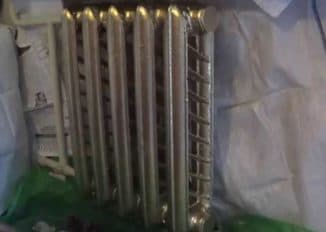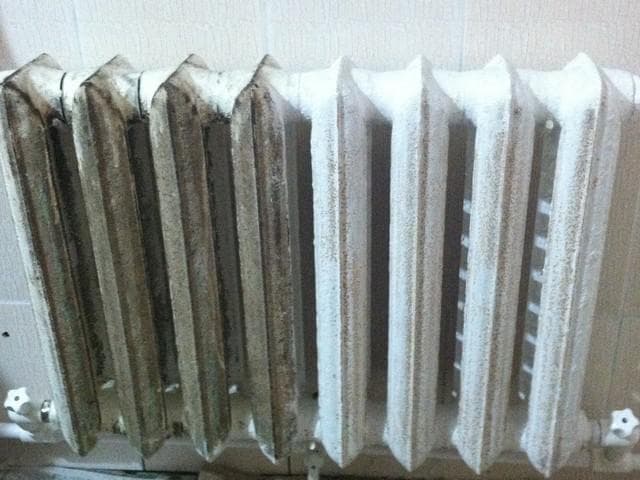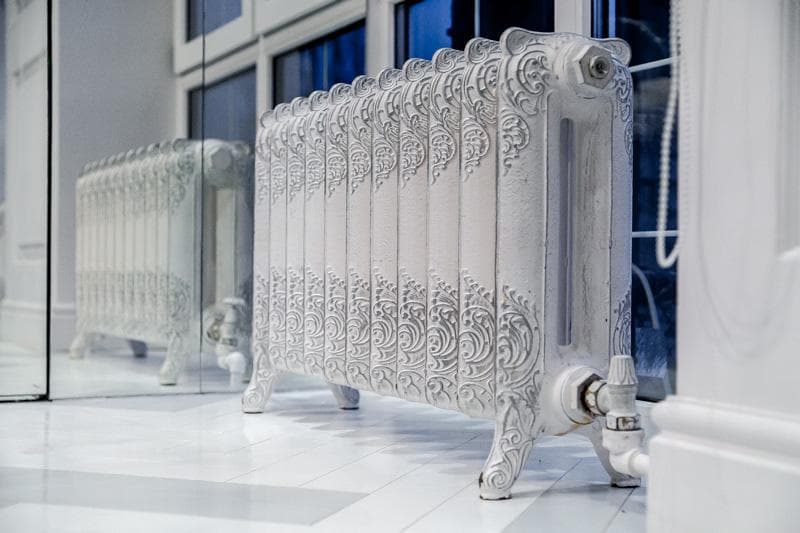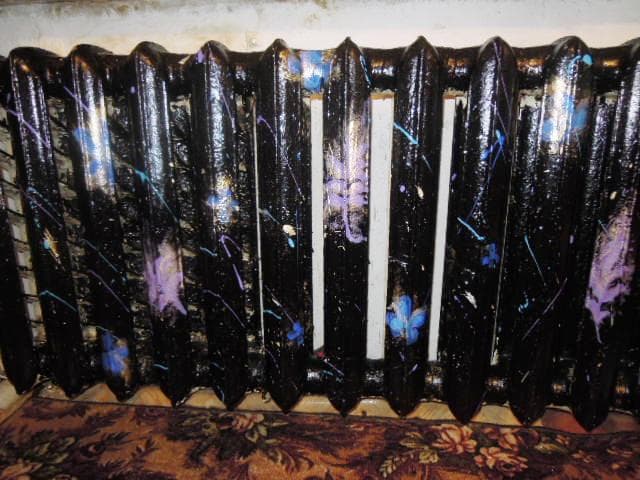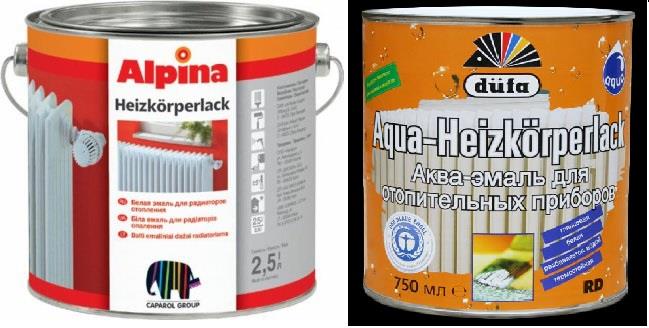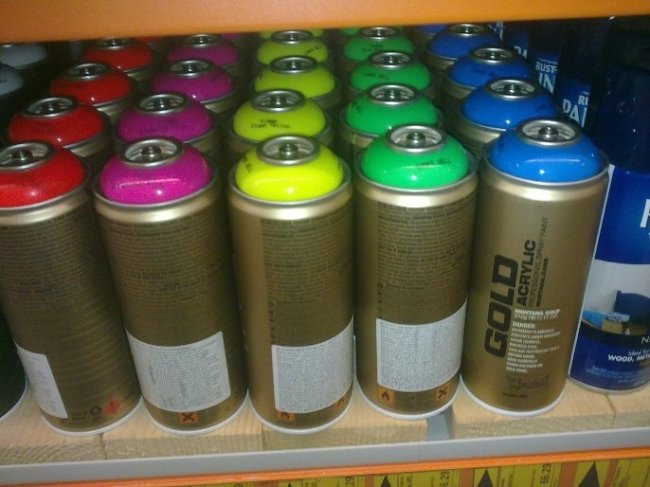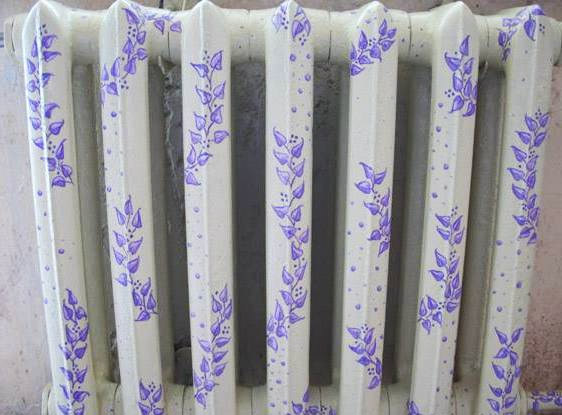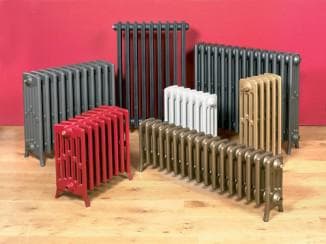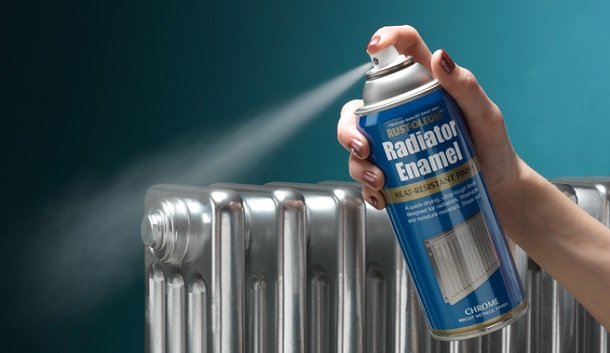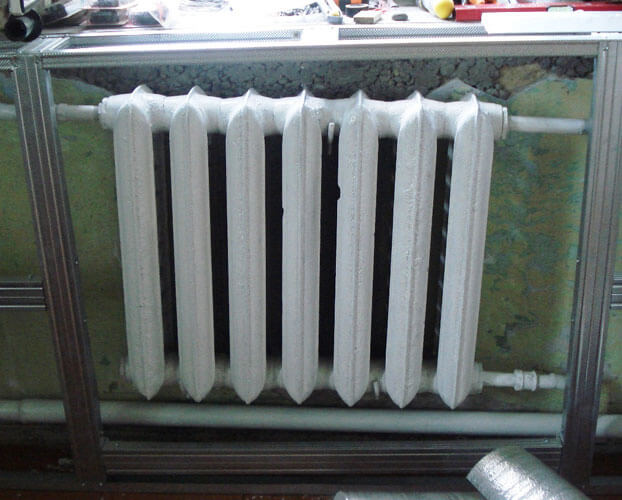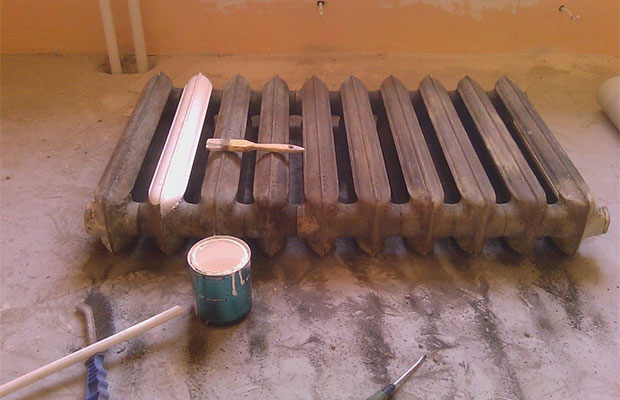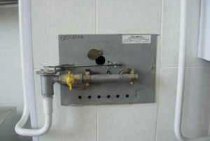Which batteries can be painted and which should not
Before considering a variety of colors, let's talk about whether all types of radiators are recommended to be painted. So, first, decide on the type of your heating battery, because it depends on whether it can be painted, or is it better to abandon this idea:
- It is undesirable to paint modern aluminum and bimetallic batteries. Initially, they are painted at the factory with resistant powder paint, which, thanks to the peculiarities of the technology, lays down perfectly evenly. If you decide that the original color of the radiator (usually white) does not match the interior of the room, and you want to repaint it, then you are unlikely to be able to achieve the same perfectly even coverage. Even if you dismantle the battery and cover it with paint in a horizontal position. In addition, an additional layer of paint will reduce heat transfer, which is a significant disadvantage for regions with severe winters.
- It is undesirable to paint plate radiators, especially those with a large surface area. They are installed in houses where a network with increased internal pressure passes. They have low convection but high heat transfer. As for our question, due to its design, it is difficult to paint a heating radiator of this type with high quality, especially with a brush. If it is really necessary, then you will have to take it off, clean it thoroughly (which is very difficult) and paint it in a horizontal position with an airbrush or spray car paint. But even so, you may not achieve a perfect application. Missing areas may remain in hard-to-reach places, because the elements of the plate radiator are too close to each other.
Important! Manufacturers recommend painting only removable metal linings, and only clean the rest of the dirt and dust
- Convectors, tubes with fins (especially those with frequent aluminum fins) should not be painted, since painting can adversely affect their heat transfer. The design of the convector, in addition to the heat source, includes a removable casing. It can be painted to enhance the overall look.
- It is recommended to paint cast iron batteries. This is not difficult to do, the colors are different and they do not affect heat transfer. The choice of color is huge.
- Painting of steel panel radiators is possible. But there is a nuance here - evenly covering the surface of the battery with a brush will not work. You will have to use automotive paint in a spray can, and it is advisable to paint in a horizontal position.
Preparation for painting the radiator
To do this, the following three states of the heating radiator can be taken into account:
- The layer of old paint does not have any cracks or chips. This means that the previous one was performed as correctly as possible, so in this case, you can proceed directly to applying a fresh coating.
- In the event that the surface of the battery has small areas with chipped and peeling paint, this means that these areas need to be sanded to get a smooth surface, and only then paint.
- Provided that the old coating has come off almost completely, painting radiators can only be done if serious preparatory work is required, which will require the use of a brush equipped with iron bristles, or a special washing solution with the addition of some alkali.
Types of dyes for batteries
The above requirements are met by many types of paints, or rather individual representatives of these types. After all, most paints are designed for temperatures below +80 ° C. Therefore, manufacturers produce special modifications of their products.
In general, do-it-yourself painting of batteries can be done with the following types of paints:
- acrylic enamels. They are based on organic solvents. This feature causes the release of the smell of the solvent during the application of the acrylic mixture to the battery. However, after drying, this smell becomes history, and a radiator with a pleasant glossy sheen appears in the room. This brilliance lasts for many years.
- Alkyd enamels. They are known for their excellent resistance to wear and high temperatures. The range of colors of these enamels is very large, so many opt for such paints. These dye solutions also give off an unpleasant odor while drying. It can also be felt in cases where the heating radiator heats up very much.
- Water-dispersion paint. Many experts note that such paint for radiators is optimal. This is because it does not upset the nose with a specific smell, and the drying time is very short. True, not every water-based mixture is suitable for batteries. Only the one on the packaging of which there is a corresponding designation is suitable. Its color can be any.
- Oil paints. They were very popular in the past. Known for emitting a solvent odor at the time of drying and a long curing time.
It is worth adding that paint for a radiator may contain elements that resist corrosion and improve adhesion (they are constantly used in primers). Such mixtures have a different color, do not require primers and cleaning the radiator from corrosion.
At least that's what the manufacturers say. In practice, it is better to remove the rust of the heater and use a primer. The processes are long, however, the result is reliable. This is often noted in various videos.
Battery painting all heating season
Who painted radiators, he knows that it is not easy
Training
The first step is to remove the old paint. In view of the fact that the design of the battery makes many of its places difficult to clean it in the old, old-fashioned way with a metal brush is not possible.
A soldering iron or hot air gun will not work. Since in the first case it is possible to damage the structure, and in the second it is simply useless
.
Paint remover will be able to remove paint even in hard-to-reach places
Of course, this method also has its drawbacks, but still it gives the best results. The wash works on the principle of a solvent. It penetrates the paint layer, softens it and then scrapes off the old paint quite simply with a spatula or metal scraper.
Among other things, the wash does not damage metal or wood, so it can be used before batteries
.

Beautiful batteries will decorate the kitchen
How to paint batteries:
The process of dyeing radiators
- apply a wash;
- remove old paint
- rust must be sanded;
- treat the battery with a degreasing agent (white spirit, or a slightly alkaline solution);
- apply a primer if necessary;
- after drying, you can apply the main color.
Think of your interesting decor of radiators
-
Batteries should only be painted when cold.
. Therefore, it is better to postpone all work for a time when the heating season has already ended. If there is a need in the autumn-winter season, close the valves and wait until it cools down completely. - If you have to paint on warm batteries, use a spray can or apply a very thin layer
. The whole difficulty of applying paint to a hot surface is that there are marks left by the brush. In addition, the paint will change and the batteries will become stained. -
You can connect radiators only after the paint has completely dried.
.

Interestingly colored batteries will be the highlight of the kitchen
How to choose the right paint for heating radiators:
Paints are different
Painting of radiators and pipes begins with the selection of substances than to paint metal. If the photo shows the amazingly beautiful painting of radiators, this does not mean at all that the master managed to achieve this effect after the first layer of paint. Coloring batteries is a rather complicated process consisting of several stages. On the modern market there are various means of painting heating radiators. Before answering the question of how to paint a battery or study the process of painting a battery captured on video, you need to figure out what kind of paint can do all this. The easiest option for selecting paint is to purchase it in a special shopping center for the sale of radiators and heating pipes.
Paint for heating appliances.
Specialists-consultants will tell you what type of paint is suitable for painting the radiator. Painting of cast-iron radiators and other elements of the heating system is carried out with paints that are resistant to abrasion. Batteries should only be painted with paints that are resistant to aggressive environments. In a video showing how to paint radiators, you rarely see the can of paint itself. And this is an important moment for those who decide to paint the batteries themselves. Battery paint must be heat resistant. The absence of toxicity of coloring substances is one of the most important points. The batteries get hot, and if the paint applied to them is toxic, this directly threatens the life and health of people in the building.
Acrylic
Paints for heating batteries are of two types. Acrylic enamels are based on organic solvents. If you paint heating radiators with them, you don’t have to worry about the appearance of the heating system for a long time, since acrylic enamels have the property of retaining shine and aesthetic appearance for a long time. They are an attractive option for those who prefer a variety of colors when painting heating radiators. However, acrylic enamels have a significant drawback: an unpleasant smell, it remains even after the radiators are painted. Moreover, when heating radiators are heated, the unpleasant odor resumes and causes discomfort.
Spray paint.
Water-dispersed
When deciding how to paint radiators, experts usually advise water-dispersed paints. They do not have a specific smell. The radiators painted by them look aesthetically pleasing. Water-dispersed paints have a wide range of colors. If you don’t know how to paint batteries, it’s better to choose them right away
In order not to make a mistake when buying, you need to pay attention to the banks in which the paint is sold. They must have a special marking indicating that the paint is suitable for painting radiators and pipelines.
It is possible to paint radiators with oil paint, but it is practically not used for this purpose.
How to choose the right paint for radiators
A wide range of different brands leads to the fact that buyers are faced with the problem of which paint to prefer.
Therefore, when choosing, it is imperative to pay attention to whether the enamel meets the following requirements:
- Lie flat on metal products;
- Provide protection against rust and corrosion damage;
- Withstand high temperatures;
- Keep the original color for a long time.
When choosing a paint, it is important to consider the material from which the radiator is made.
In addition, it is also necessary to take into account what material the batteries and radiators are made of. After all, they can be made from a variety of metals, as well as their alloys. Experts recommend following a few tips:
- For devices made of steel, aluminum and bimetallic composition, it is better to use acrylic or alkyd paints;
- Enamels of any kind, except for oil, are well suited for cast-iron batteries. However, in order for the substance to lay down in an even and thin layer, it must be mixed with a diluent;
- It is better to refuse to use oil paints of even the most famous brands, because it very rarely performs protective and decorative functions at the same level as others.
Features of preparation
There are two ways to remove a layer of old paint:
The first involves the use of a spatula or a round metal brush attached to an electric drill. Working with a spatula requires physical effort, since they need to be moved by their own hands. Moreover, it will take a long time to wash the paint. This must be taken into account in calculating the total staining time. The disadvantage of this option is that it is difficult to reach the bottom of thin slots.
A round metal brush mounted on an electric drill is a more versatile method.
The chemical method involves the use of special solvents or fatty acids. They process the entire area of \u200b\u200bthe battery and cover the treated surface with a film. Then they rest. The duration of the rest is indicated on the package. It may be different. During it, the paint becomes soft. Of course, it does not slip (and it would be very good), but its removal with a spatula, grinder or wire brush becomes very easy.
It is worth remembering that solvents emit substances harmful to the body. Therefore, when using the chemical method, you need to protect your hands with construction gloves, the airways with a gauze bandage, and even better with a respirator.
The surface of the radiator, cleaned of paint, is treated with sandpaper. They work especially carefully in places where there is corrosion. It needs to be completely removed. Only a pure metallic sheen should remain.
For degreasing use white spirit or any other alkaline solution.
The primer of the radiator is carried out with a solution that meets the following requirements:
- is a product of the same manufacturer that produced the paint. In this case, the primer and paint are best suited to each other;
- contains substances that can resist corrosion.
Choosing the Perfect Battery Paint
It is important to determine which paint is best for transforming radiators. There are a number of requirements that must be met by paint applied to batteries.
At least one hundred degrees heat resistance of the paint is required, abrasion resistance, non-toxicity are also needed, since the batteries are regularly cleaned, and the radiator itself heats up. The paint containing metallic powder instead of coloring pigments differs in the highest heat resistance.
There are special paints for radiators on sale, many use water-based enamels, heat-resistant varnishes. The selected paint must necessarily be designed to cover the metal, match the primer. Good compositions are durable, do not change color, and are able to protect themselves from corrosion.
Glossy gloss, color fastness for a long time are provided with acrylic enamels on organic solvents. But they smell pretty strong when applied.
Water-dispersion paints will dry quickly, but it is important to choose them carefully by choosing special types. After painting with alkyd enamels, the uniformity of the coating is guaranteed, it will be durable and resistant to impacts.
However, the smell can be observed not only during the painting process, but also some time later after drying, standing out from heating.
Color selection
The decision in what color it is better to paint the radiators is up to the owners. Now available a wide range of funds, a variety of compositions. Classical is considered to be white enamel, silver. Some choose colors in accordance with the interior, lighting, general style of the apartment and design features.Gold and bronze shades, subtle patterns, drawings look unusual.
If the look of your old radiators no longer pleases you, then you can try to breathe new life into them with the help of experiments.
- The quality of painting cast iron batteries also largely depends on how well they are prepared. As a tool for applying paint, a smooth foam roller of small diameter is best suited, and a brush is useful in hard-to-reach places. To decide for yourself how to paint the most convenient, you should think about removing the batteries. The radiator separated from the pipes can be covered with a composition on all sides, so there will be much less inaccessible places. At the same time, this method does not always justify itself, sometimes it is easier to paint over the battery more carefully without wasting time removing it. It all depends on the specific circumstances, the shape of the radiator.
- A very important factor is the temperature of the painted surface: the radiator must be cold. To the question “is it possible to paint hot batteries?” any specialist will answer unequivocally: this cannot be done. The most convenient moment is the time when there is no heating season. But the beginning of the heating period will not be a hindrance if you close the valves on the batteries, stopping the access of boiling water. It is enough to wait for them to cool completely to start painting. In the case of applying paint to a hot radiator, it will lie unevenly, swell, and various spots and stains will probably form. Moreover, you can connect the heating only when the paint is completely dry.
Painting radiators and heating pipes requires care and accuracy. It is good to use brushes, small rollers, spray cans. From the spray gun, it is optimal to process a previously removed battery, then all hard-to-reach areas will be perfectly painted over. It is from those places that are the least accessible that staining should begin.
It is important to observe a uniform layer thickness, otherwise the color may subsequently differ in different areas.
It is recommended to start painting from above, then accidental streaks will not spoil the lower part. You need to cover the whole battery with the composition, not limited to its front part
It is more effective to apply the paint in two thin layers, and wait for the first one to dry completely before re-painting. Then there will be no streaks, and ideal evenness is easier to achieve with thin layers.
Battery preparation before painting
Before applying a layer of paint to the battery, make sure that the metal surface of the heating radiator is clean. Even new batteries need preliminary preparation: cleaning, sanding, degreasing. All this is done to ensure that the new coating is in maximum contact with the surface of the battery, providing better heat dissipation. An unprepared surface can lead to a number of unpleasant consequences: paint cracking, violation of the integrity of the coating layer in certain places of the radiator, etc. The same applies to pipes: before wondering whether they must also be prepared for painting and apply a layer of paint that will reliably protect the pipes from destruction.
Very often, old radiators are used in heating systems, on which a layer of oil paint remains. Such batteries can be used in the absence of defects, but it is necessary to carefully clean the entire surface of the heater from old paint, soil and rust. The old layer of paint can be removed with sandpaper and special solvents. It is good if there is a building hair dryer among the tools - it will significantly speed up the cleaning process.
After we are convinced of the ideal cleanliness of the surface of the heating radiator, you can proceed to its priming.The primer is applied in a thin layer over the entire radiator with a brush or spray gun (the latter is relevant if we have not figured it out yet, or the heating system has not yet been installed). We will not advertise any particular brand of primer, we only note that it should be intended for application to metal surfaces.
Radiator paint
Without radiators in our climate is not easy
In our harsh climate, additional heating sources are indispensable. Of course, modern technologies do not stand still and more and more often systems are installed in houses, but the batteries we are used to can still be found in many houses
.
Batteries, no matter how useful they are in the winter season, are constantly criticized. Their design rarely fits into the interior of the room. Such cast-iron, bulky structures are appropriate only in an industrial loft style.
.
In addition to the bulky and awkward design, batteries are not so easy to care for. Firstly, they perfectly collect dust, which must be periodically “sweeped” with the help of all sorts of tricks. But periodically they need to be painted, which is even more difficult to do. How to do it right, we analyze in stages.
Everything needs order
The calculation of the amount of paint required will help to make inscriptions on the bank where it is located. However, it is best to purchase it with a small margin. This is especially true if the batteries have been in operation for more than a year. How to paint the heating system? There are a few simple rules that must be followed for high-quality staining. The paint is applied first at the top. Gradually, the staining goes down. The first to paint the internal ceilings of the battery, then the external ones. How to paint so that the coating is of high quality and smooth? Only two layers. If you have a choice: one thick coat of paint or two thin ones, choose the second option, only it will provide an even coverage.
Painting the battery with an aerosol can.
There is another type of radiator painting, where brushes are not required. An airbrush or spray can is an attractive option for those who are used to saving their time. In such a case, a thin uniform layer is provided. But one of the stages of preparing the battery for painting will be its removal so that you can apply paint to all its hard-to-reach areas. There is a wide range of heat-resistant paint cans on the market. Using them is quite simple and will not be difficult for a person who has never used them.
Previously, it was considered the norm that the battery was painted white. However, the interior design fashion began to dictate its own rules in the coloring of heating systems. Batteries in bronze and silver colors are considered a sign of vintage style. In children's rooms, more and more often you can find radiators that imitate a rainbow. Small drawings on batteries are considered super fashionable: ornaments, flowers, leaves, animal tracks
Two trends can be distinguished in the painting of batteries: either they are tried to be made as inconspicuous as possible, and they merge with the color of the walls, or they are painted so that they attract attention
https://youtube.com/watch?v=eAuZcc1f3uw
The main thing here is not to forget about the sense of proportion and that the heating system should ideally fit harmoniously into the functional and aesthetic space of the room. When performing work on preparing metal for painting and its further painting, one should not forget about safety precautions, take care of the protection of hands and respiratory organs.
The need to paint the battery
So, the unit should be coated with a coloring compound if:
- Purchased a new heater. Many residents very often have a question about how to paint a cast-iron battery, since devices made of this material are often supplied unpainted;
- it was decided to carry out repair work in order to update the interior of the premises;
- during operation, the heater lost its normal appearance and turned into an outdated unit with peeling paint. This is especially true of traditional cast iron batteries, which were so popular in the last century.
The second upgrade method is dismantling the batteries
There is another way to change the appearance of the batteries. It is more time consuming, because you have to completely remove the radiators. However, as a result, you will be much better at cleaning the batteries from rust and dirt. First you need to reset the heating risers. After that, you will need to completely unscrew all the through and blind plugs, as well as remove the jumpers. Next, you need to anneal the battery (heat and hold at a high temperature) using a powerful household hair dryer. Then we disassemble the radiator into sections, using a special key for this. Don't forget to tap the radiators with a mallet to remove any rust. After that, the sections are cleaned with a metal brush.
In the next step, reassemble the battery using ordinary rubber gaskets. In this case, the size of the outer part should be slightly smaller than the end of each section. After that, install and connect the radiator to the heating network. Apply a primer to the surface of a clean battery and start painting. The algorithm of work is almost the same. The only difference is that the batteries will not be as hot as in the first case. Because of this, they will dry a little longer. Often, residents of houses paint radiators immediately after they are dismantled. In this case, it is possible to paint the surface both in front and behind the battery. In addition, there is no risk of staining the wall behind the radiator.
What tools and materials are needed for work
Not always and not everyone has the opportunity to change batteries. A universal way out of this situation will be painting the radiators in any color you like. To work, you do not need to have certain skills, but you will need to purchase some materials and stock up on tools. The purchased paint must be resistant to high temperatures. This property is necessary, since in winter the radiators of the heating system heat up and become very hot.
In addition, the composition must retain its original color for a long period of time. A rather important factor is also considered the absence of a smell in the paint, so that after work it is not necessary to ventilate the living quarters. Before you learn how to paint, you need to figure out the paints that are suitable for this. So, in stores you can always find acrylic compositions. They are distinguished by the absence of a pungent odor and the ability to retain their color for quite a long time.
Oil formulations are also often found in stores, but not many people buy them. This is due to the emergence of safer formulations of the first two types. All of these paints work in one way or another. Painting radiators with your own hands using these materials will give a positive result if you follow the operating instructions and dilute the paint with a solvent in the proportion indicated by the manufacturer.
To quickly complete the work and not be distracted, you will need to stock up on the necessary equipment. So, you will need:
- fine-grained sandpaper;
- a knife or other sharp object for cleaning radiators;
- several brushes of different shapes:
- small roller;
- old rags.
With everything you need at hand, you can get to work.
It is very important to stock up on rubber gloves and a protective mask, which will help protect the skin from stains and the respiratory tract from fumes.
The choice of paint for radiators
Batteries should be painted with special paints that meet certain requirements. They must be resistant to high temperatures, not corrode and not change color during operation.Most often, the following types of coatings are used for painting radiators:
- Alkyd enamels. They are highly resistant to abrasion and can withstand temperatures up to 90°C. But they dry for a long time, have a pungent odor and are toxic, since they are based on organic solvents. In addition, they often turn yellow and in some cases may crack.
- Acrylic enamels based on aqueous solvents. They are practically odorless, safe for humans. Dry within 40 minutes and retain color until the next staining. They must be applied only on a primed surface, which prevents the contact of the aqueous solvent with the metal, due to which rust can appear through the paint layer.
- First of all, the surface to be painted must be well prepared. If necessary, the old paint is removed with a solvent and a spatula. Next, the surface of the radiator is cleaned with sandpaper, thereby removing all the irregularities and creating a rough layer that improves the adhesion of the new paint. After that, it is necessary to carefully remove all dust with a soft brush.
- A primer layer is applied to the cleaned surface of the battery, which corresponds to the characteristics of the paint used. Usually this information can be found in the instructions for use of the coating or similar recommendations are given by the seller of a specialized store.
- After the primer has completely dried, you can start applying decorative enamel. It is necessary to paint the entire battery completely, leaving no unpainted spots that can later cause corrosion on the entire surface. First, internal and hard-to-reach places are painted with a long radiator brush, and then the enamel is applied to the outer surface of the battery using a flat paint brush. Painting should be done from top to bottom to avoid streaks.
- It is recommended to apply paint in two layers. In this case, the second layer is applied only after the previous layer has completely dried. To get a smoother surface, you should try to make the layers as thin as possible.
- In order not to stain the wall behind the battery with paint, you can cover it with cardboard or plastic.
- When the battery is painted, you can connect it to the heating only after the paint has completely dried.
You can diversify the interior and give the battery a decorative look by tinting traditional white enamel. You can disguise the radiator to match the color of the wall or choose metallic shades - like gold, silver or copper. Batteries painted with mother-of-pearl, chameleon or wood effects look unusual. Often, a pattern or ornament of varying complexity is applied to the batteries. Following the above recommendations, you can give the batteries a beautiful look and keep it for a long time.
